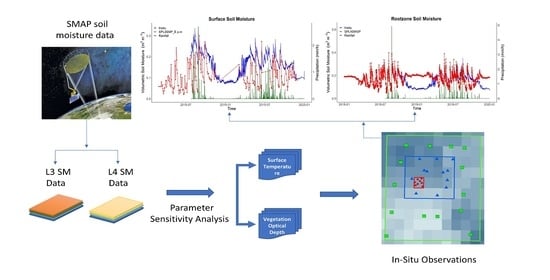Multi-Scale Assessment of SMAP Level 3 and Level 4 Soil Moisture Products over the Soil Moisture Network within the ShanDian River (SMN-SDR) Basin, China
Abstract
:1. Introduction
2. Materials and Methods
2.1. Study Domain and Ground Observation Network and Datasets
2.2. SMAP Soil Moisture Products
2.3. Statistical Analysis
3. Results
3.1. Evaluation of the SPL4SMGP Surface and Root-Zone Soil Moisture
3.2. Evaluation of SPL3SMP_E Ascending and Descending SM
3.3. Comparison of SPL3SMP_E and SPL4SMGP Surface Soil Moisture
3.4. Performance Assessment of the SMAP SM L3 and L4 Products under Various Vegetation Types
4. Discussion
4.1. Factors Affecting the SMAP SM Retrieval Algorithm
4.2. Impact of the Physical Surface Temperature on the SMAP SM Retrieval Algorithm
4.3. Impact of the Vegetation Optical Depth on the SMAP SM Retrieval Algorithm
5. Conclusions
- (a)
- The ubRMSE values for SPL4SMGP SSM and RZSM retrievals are less than 0.04 for sparse network sites (M and L). The averaged ubRMSE of SPL4SMGP SSM (RZSM) estimates are about 0.037 (0.017 ) with correlation values of 0.62 (0.78) against the sparse network at a 9-km resolution, respectively. The core validation sites (S) showed ubRMSE values of 0.044 (0.020 ) for SSM (RZSM) estimates with the R values of 0.56 (0.48), respectively.
- (b)
- For SPL3SMP_E a.m. SM, the ubRMSE values are close to 0.04 with R values larger than 0.56. The SPL3SMP_E a.m. (p.m.) SM has averaged ubRMSE values of 0.041 (0.050 ) with correlation values of 0.62 (0.42) against the sparse network at a 9-km resolution, respectively. The SPL3SMP_E p.m. SM estimates are less accurate than the a.m. retrievals.
- (c)
- For SSM evaluation, the skills of the SPL4SMGP SSM retrievals exceed that of the SPL3SMP_E (a.m. and p.m.) SM estimations.
- (d)
- Under different vegetation types, the SMAP L4 products performed well with high correlation (0.70) and less ubRMSE (0.019 ) values than L3 products. Both products (L3 and L4) showed good accuracy in grassland, then farmland, and lowest in the woodland. The performance of these products was influenced by factors, such as the vegetation copy and physical surface temperature, in different study area locations.
Author Contributions
Funding
Institutional Review Board Statement
Informed Consent Statement
Data Availability Statement
Conflicts of Interest
References
- Brocca, L.; Ciabatta, L.; Massari, C.; Camici, S.; Tarpanelli, A. Soil moisture for hydrological applications: Open questions and new opportunities. Water 2017, 9, 140. [Google Scholar] [CrossRef]
- Corradini, C. Soil moisture in the development of hydrological processes and its determination at different spatial scales. J. Hydrol. 2014, 516, 1–5. [Google Scholar] [CrossRef]
- De Rosnay, P.; Drusch, M.; Boone, A.; Balsamo, G.; Decharme, B.; Harris, P.; Kerr, Y.; Pellarin, T.; Polcher, J.; Wigneron, J.P. AMMA land surface model intercomparison experiment coupled to the community microwave emission model: ALMIP-MEM. J. Geophys. Res. Atmos. 2009, 114, D05108. [Google Scholar] [CrossRef]
- Miralles, D.G.; Van Den Berg, M.J.; Gash, J.H.; Parinussa, R.M.; De Jeu, R.A.M.; Beck, H.E.; Holmes, T.R.H.; Jiménez, C.; Verhoest, N.E.C.; Dorigo, W.A.; et al. El Niño-La Niña cycle and recent trends in continental evaporation. Nat. Clim. Chang. 2014, 4, 122–126. [Google Scholar] [CrossRef]
- Hirschi, M.; Seneviratne, S.I.; Alexandrov, V.; Boberg, F.; Boroneant, C.; Christensen, O.B.; Formayer, H.; Orlowsky, B.; Stepanek, P. Observational evidence for soil-moisture impact on hot extremes in southeastern Europe. Nat. Geosci. 2011, 4, 17–21. [Google Scholar] [CrossRef]
- Massari, C.; Brocca, L.; Moramarco, T.; Tramblay, Y.; Didon Lescot, J.F. Potential of soil moisture observations in flood modelling: Estimating initial conditions and correcting rainfall. Adv. Water Resour. 2014, 74, 44–53. [Google Scholar] [CrossRef]
- Dorigo, W.A.; Xaver, A.; Vreugdenhil, M.; Gruber, A.; Hegyiová, A.; Sanchis-Dufau, A.D.; Zamojski, D.; Cordes, C.; Wagner, W.; Drusch, M. Global Automated Quality Control of In Situ Soil Moisture Data from the International Soil Moisture Network. Vadose Zone J. 2013, 12, vzj2012.0097. [Google Scholar] [CrossRef]
- An, R.; Zhang, L.; Wang, Z.; Quaye-Ballard, J.A.; You, J.; Shen, X.; Gao, W.; Huang, L.J.; Zhao, Y.; Ke, Z. Validation of the ESA CCI soil moisture product in China. Int. J. Appl. Earth Obs. Geoinf. 2016, 48, 28–36. [Google Scholar] [CrossRef]
- Entekhabi, D.; Njoku, E.G.; O’Neill, P.E.; Kellogg, K.H.; Crow, W.T.; Edelstein, W.N.; Entin, J.K.; Goodman, S.D.; Jackson, T.J.; Johnson, J.; et al. The soil moisture active passive (SMAP) mission. Proc. IEEE 2010, 98, 704–716. [Google Scholar] [CrossRef]
- Piepmeier, J.R.; Focardi, P.; Horgan, K.A.; Knuble, J.; Ehsan, N.; Lucey, J.; Brambora, C.; Brown, P.R.; Hoffman, P.J.; French, R.T.; et al. SMAP L-Band Microwave Radiometer: Instrument Design and First Year on Orbit. IEEE Trans. Geosci. Remote Sens. 2017, 55, 1954–1966. [Google Scholar] [CrossRef] [Green Version]
- Kerr, Y.H.; Njoku, E.G. A Semiempirical Model for Interpreting Microwave Emission from Semiarid Land Surfaces as Seen from Space. IEEE Trans. Geosci. Remote Sens. 1990, 28, 384–393. [Google Scholar] [CrossRef]
- Hoang, K.O.; Lu, M. Assessment of the temperature effects in smap satellite soil moisture products in oklahoma. Remote Sens. 2021, 13, 4104. [Google Scholar] [CrossRef]
- Xu, X. Evaluation of smap level 2, 3, and 4 soil moisture datasets over the Great Lakes region. Remote Sens. 2020, 12, 3785. [Google Scholar] [CrossRef]
- Cui, C.; Xu, J.; Zeng, J.; Chen, K.S.; Bai, X.; Lu, H.; Chen, Q.; Zhao, T. Soil moisture mapping from satellites: An intercomparison of SMAP, SMOS, FY3B, AMSR2, and ESA CCI over two dense network regions at different spatial scales. Remote Sens. 2018, 10, 33. [Google Scholar] [CrossRef] [Green Version]
- Ducharne, A.; Koster, R.D.; Suarez, M.J.; Stieglitz, M.; Kumar, P. A catchment-based approach to modeling land surface processes in a general circulation model 2. Parameter estimation and model demonstration. J. Geophys. Res. Atmos. 2000, 105, 24823–24838. [Google Scholar] [CrossRef]
- Koster, R.D.; Suarez, M.J.; Ducharne, A.; Stieglitz, M.; Kumar, P. A catchment-based approach to modeling land surface processes in a general circulation model: 1. Model structure. J. Geophys. Res. Atmos. 2000, 105, 24809–24822. [Google Scholar] [CrossRef]
- De Lannoy, G.J.M.; Reichle, R.H. Assimilation of SMOS brightness temperatures or soil moisture retrievals into a land surface model. Hydrol. Earth Syst. Sci. 2016, 20, 4895–4911. [Google Scholar] [CrossRef] [Green Version]
- De Lannoy, G.J.M.; Reichle, R.H. Global assimilation of multiangle and multipolarization SMOS brightness temperature observations into the GEOS-5 catchment land surface model for soil moisture estimation. J. Hydrometeorol. 2016, 17, 669–691. [Google Scholar] [CrossRef] [Green Version]
- Su, Z.; Wen, J.; Dente, L.; Van Der Velde, R.; Wang, L.; Ma, Y.; Yang, K.; Hu, Z. The tibetan plateau observatory of plateau scale soil moisture and soil temperature (Tibet-Obs) for quantifying uncertainties in coarse resolution satellite and model products. Hydrol. Earth Syst. Sci. 2011, 15, 2303–2316. [Google Scholar] [CrossRef] [Green Version]
- Su, Z.; De Rosnay, P.; Wen, J.; Wang, L.; Zeng, Y. Evaluation of ECMWF’s soil moisture analyses using observations on the Tibetan Plateau. J. Geophys. Res. Atmos. 2013, 118, 5304–5318. [Google Scholar] [CrossRef] [Green Version]
- Chen, Y.; Yang, K.; Qin, J.; Zhao, L.; Tang, W.; Han, M. Evaluation of AMSR-E retrievals and GLDAS simulations against observations of a soil moisture network on the central Tibetan Plateau. J. Geophys. Res. Atmos. 2013, 118, 4466–4475. [Google Scholar] [CrossRef]
- Liu, Q.; Du, J.Y.; Shi, J.C.; Jiang, L.M. Analysis of spatial distribution and multi-year trend of the remotely sensed soil moisture on the Tibetan Plateau. Sci. China Earth Sci. 2013, 56, 2173–2185. [Google Scholar] [CrossRef]
- Bi, H.; Ma, J.; Zheng, W.; Zeng, J. Comparison of soil moisture in GLDAS model simulations and in situ observations over the Tibetan Plateau. J. Geophys. Res. 2016, 121, 2658–2678. [Google Scholar] [CrossRef] [Green Version]
- Ma, C.; Li, X.; Wei, L.; Wang, W. Multi-scale validation of SMAP soil moisture products over cold and arid regions in Northwestern China using distributed ground observation data. Remote Sens. 2017, 9, 327. [Google Scholar] [CrossRef] [Green Version]
- Zhang, X.; Zhang, T.; Zhou, P.; Shao, Y.; Gao, S. Validation analysis of SMAP and AMSR2 soil moisture products over the United States using ground-based measurements. Remote Sens. 2017, 9, 104. [Google Scholar] [CrossRef] [Green Version]
- Li, C.; Lu, H.; Yang, K.; Han, M.; Wright, J.S.; Chen, Y.; Yu, L.; Xu, S.; Huang, X.; Gong, W. The evaluation of SMAP enhanced soil moisture products using high-resolution model simulations and in-situ observations on the Tibetan Plateau. Remote Sens. 2018, 10, 535. [Google Scholar] [CrossRef] [Green Version]
- Hu, F.; Wei, Z.; Zhang, W.; Dorjee, D.; Meng, L. A spatial downscaling method for SMAP soil moisture through visible and shortwave-infrared remote sensing data. J. Hydrol. 2020, 590, 125360. [Google Scholar] [CrossRef]
- Colliander, A.; Reichle, R.; Crow, W.; Cosh, M.; Chen, F.; Chan, S.; Das, N.; Bindlish, R.; Chaubell, J.; Kim, S.; et al. Validation of Soil Moisture Data Products from the NASA SMAP Mission. IEEE J. Sel. Top. Appl. Earth Obs. Remote Sens. 2021, 15, 364–392. [Google Scholar] [CrossRef]
- Al-Yaari, A.; Wigneron, J.P.; Dorigo, W.; Colliander, A.; Pellarin, T.; Hahn, S.; Mialon, A.; Richaume, P.; Fernandez-Moran, R.; Fan, L.; et al. Assessment and inter-comparison of recently developed/reprocessed microwave satellite soil moisture products using ISMN ground-based measurements. Remote Sens. Environ. 2019, 224, 289–303. [Google Scholar] [CrossRef]
- O’Neill, P.E.; Chan, S.; Njoku, E.G.; Jackson, T.; Bindlish, R.; Chaubell, J. SMAP Enhanced L3 Radiometer Global Daily 9 km EASE-Grid Soil Moisture, Version 4; National Snow and Ice Data Center: Boulder, CO, USA, 2020; pp. 1–26. [Google Scholar]
- Fascetti, F.; Pierdicca, N.; Pulvirenti, L.; Crapolicchio, R. SMOS, ASCAT, SMAP and ERA soil moisture comparison through the triple and quadruple collocation technique. In Proceedings of the SPIE Remote Sensing, Edinburgh, UK, 26–29 September 2016; Volume 10003, p. 100030H. [Google Scholar] [CrossRef]
- Reichle, R.H.; de Lannoy, G.J.M.; Liu, Q.; Koster, R.D.; Kimball, J.S.; Crow, W.T.; Ardizzone, J.V.; Chakraborty, P.; Collins, D.W.; Conaty, A.L.; et al. Global assessment of the SMAP Level-4 surface and root-zone soil moisture product using assimilation diagnostics. J. Hydrometeorol. 2017, 18, 3217–3237. [Google Scholar] [CrossRef]
- Chen, F.; Crow, W.T.; Bindlish, R.; Colliander, A.; Burgin, M.S.; Asanuma, J.; Aida, K. Global-scale evaluation of SMAP, SMOS and ASCAT soil moisture products using triple collocation. Remote Sens. Environ. 2018, 214, 1–13. [Google Scholar] [CrossRef] [PubMed]
- Burgin, M.S.; Colliander, A.; Njoku, E.G.; Chan, S.K.; Cabot, F.; Kerr, Y.H.; Bindlish, R.; Jackson, T.J.; Entekhabi, D.; Yueh, S.H. A Comparative Study of the SMAP Passive Soil Moisture Product with Existing Satellite-Based Soil Moisture Products. IEEE Trans. Geosci. Remote Sens. 2017, 55, 2959–2971. [Google Scholar] [CrossRef] [PubMed]
- Colliander, A.; Cosh, M.H.; Misra, S.; Jackson, T.J.; Crow, W.T.; Chan, S.; Bindlish, R.; Chae, C.; Holifield Collins, C.; Yueh, S.H. Validation and scaling of soil moisture in a semi-arid environment: SMAP validation experiment 2015 (SMAPVEX15). Remote Sens. Environ. 2017, 196, 101–112. [Google Scholar] [CrossRef]
- Colliander, A.; Cosh, M.H.; Misra, S.; Jackson, T.J.; Crow, W.T.; Powers, J.; McNairn, H.; Bullock, P.; Berg, A.; Magagi, R.; et al. Comparison of high-resolution airborne soil moisture retrievals to SMAP soil moisture during the SMAP validation experiment 2016 (SMAPVEX16). Remote Sens. Environ. 2019, 227, 137–150. [Google Scholar] [CrossRef]
- Jackson, T.J.; Schmugge, T.J. Vegetation effects on the microwave emission of soils. Remote Sens. Environ. 1991, 36, 203–212. [Google Scholar] [CrossRef]
- Njoku, E.G.; Entekhabi, D. Passive microwave remote sensing of soil moisture. J. Hydrol. 1996, 184, 101–129. [Google Scholar] [CrossRef]
- Wraith, J.M.; Or, D. Temperature effects on soil bulk dielectric permittivity measured by time domain reflectometry: Experimental evidence and hypothesis development. Water Resour. Res. 1999, 35, 361–369. [Google Scholar] [CrossRef]
- Zhao, T.; Shi, J.; Lv, L.; Xu, H.; Chen, D.; Cui, Q.; Jackson, T.J.; Yan, G.; Jia, L.; Chen, L.; et al. Soil moisture experiment in the Luan River supporting new satellite mission opportunities. Remote Sens. Environ. 2020, 240, 111680. [Google Scholar] [CrossRef]
- Cui, H.; Jiang, L.; Du, J.; Zhao, S.; Wang, G.; Lu, Z.; Wang, J. Evaluation and analysis of AMSR-2, SMOS, and SMAP soil moisture products in the Genhe area of China. J. Geophys. Res. Atmos. 2017, 122, 8650–8666. [Google Scholar] [CrossRef]
- Kellogg, K.; Thurman, S.; Edelstein, W.; Spencer, M.; Chen, G.S.; Underwood, M.; Njoku, E.; Goodman, S.; Jai, B. NASA’s soil moisture active passive (SMAP) observatory. In Proceedings of the 2013 IEEE Aerospace Conference, Big Sky, MT, USA, 2–9 March 2013; pp. 1–20. [Google Scholar] [CrossRef]
- Entekhabi, D.; Yueh, S.; O’Neil, P.E.; Kellogg, K.H.; Allen, A.; Bindlish, R.; Brown, M.; Chan, S.; Colliander, A.; Crow, W.T.; et al. SMAP Handbook: Soil Moisture Active Passive, Mapping Soil Moisture and Freeze/Thaw from Space; National Aeronautics and Space Administration: Washington, DC, USA, 2014; p. 192.
- Reichle, R.; De Lannoy, G.; Koster, R.D.; Crow, W.T.; Kimball, J.S.; Liu, Q. SMAP L4 Global 3-Hourly 9 km EASE-Grid Surface and Root Zone Soil Moisture Analysis Update, Version 4; National Snow and Ice Data Center: Boulder, CO, USA, 2018. [Google Scholar]
- Chan, S.K.; Bindlish, R.; O’Neill, P.; Jackson, T.; Njoku, E.; Dunbar, S.; Chaubell, J.; Piepmeier, J.; Yueh, S.; Entekhabi, D.; et al. Development and assessment of the SMAP enhanced passive soil moisture product. Remote Sens. Environ. 2018, 204, 931–941. [Google Scholar] [CrossRef] [Green Version]
- Qiu, J.; Dong, J.; Crow, W.T.; Zhang, X.; Reichle, R.H.; De Lannoy, G.J.M. The benefit of brightness temperature assimilation for the SMAP Level-4 surface and root-zone soil moisture analysis. Hydrol. Earth Syst. Sci. 2021, 25, 1569–1586. [Google Scholar] [CrossRef]
- Rodriguez-Iturbe, I.; Vogel, G.K.; Rigon, R.; Entekhabi, D.; Castelli, F.; Rinaldo, A. On the spatial organization of soil moisture fields. Geophys. Res. Lett. 1995, 22, 2757–2760. [Google Scholar] [CrossRef]
- Entekhabi, D.; Reichle, R.H.; Koster, R.D.; Crow, W.T. Performance metrics for soil moisture retrievals and application requirements. J. Hydrometeorol. 2010, 11, 832–840. [Google Scholar] [CrossRef]
- Reichle, R.H.; Koster, R.D.; Liu, P.; Mahanama, S.P.P.; Njoku, E.G.; Owe, M. Comparison and assimilation of global soil moisture retrievals from the Advanced Microwave Scanning Radiometer for the Earth Observing System (AMSR-E) and the Scanning Multichannel Microwave Radiometer (SMMR). J. Geophys. Res. Atmos. 2007, 112, D09108. [Google Scholar] [CrossRef]
- Zhang, L.; He, C.; Zhang, M. Multi-scale evaluation of the SMAP product using sparse in-situ network over a high mountainous Watershed, Northwest China. Remote Sens. 2017, 9, 1111. [Google Scholar] [CrossRef] [Green Version]
- Derksen, C.; Xu, X.; Scott Dunbar, R.; Colliander, A.; Kim, Y.; Kimball, J.S.; Black, T.A.; Euskirchen, E.; Langlois, A.; Loranty, M.M.; et al. Retrieving landscape freeze/thaw state from Soil Moisture Active Passive (SMAP) radar and radiometer measurements. Remote Sens. Environ. 2017, 194, 48–62. [Google Scholar] [CrossRef]
- Reichle, R.H.; De Lannoy, G.J.M.; Liu, Q.; Ardizzone, J.V.; Colliander, A.; Conaty, A.; Crow, W.; Jackson, T.J.; Jones, L.A.; Kimball, J.S.; et al. Assessment of the SMAP Level-4 surface and root-zone soil moisture product using in situ measurements. J. Hydrometeorol. 2017, 18, 2621–2645. [Google Scholar] [CrossRef]
- Wang, Z.; Che, T.; Zhao, T.; Dai, L.; Li, X.; Wigneron, J.P. Evaluation of SMAP, SMOS, and AMSR2 soil moisture products based on distributed ground observation network in cold and arid regions of China. IEEE J. Sel. Top. Appl. Earth Obs. Remote Sens. 2021, 14, 8955–8970. [Google Scholar] [CrossRef]
- Jackson, T.J.; Cosh, M.H.; Bindlish, R.; Starks, P.J.; Bosch, D.D.; Seyfried, M.; Goodrich, D.C.; Moran, M.S.; Du, J. Validation of advanced microwave scanning radiometer soil moisture products. IEEE Trans. Geosci. Remote Sens. 2010, 48, 4256–4272. [Google Scholar] [CrossRef]
- Thomas, J.J. Measuring Surface Soil Moisture Using Passive Microwave Remote Sensing. Hydrol. Process. 1993, 7, 139–152. [Google Scholar]
- Leroux, D.J.; Kerr, Y.H.; Al Bitar, A.; Bindlish, R.; Jackson, T.J.; Berthelot, B.; Portet, G. Comparison between SMOS, VUA, ASCAT, and ECMWF soil moisture products over four watersheds in U.S. IEEE Trans. Geosci. Remote Sens. 2014, 52, 1562–1571. [Google Scholar] [CrossRef] [Green Version]
- Konings, A.G.; Piles, M.; Das, N.; Entekhabi, D. L-band vegetation optical depth and effective scattering albedo estimation from SMAP. Remote Sens. Environ. 2017, 198, 460–470. [Google Scholar] [CrossRef]
- Tian, F.; Wigneron, J.P.; Ciais, P.; Chave, J.; Ogée, J.; Peñuelas, J.; Ræbild, A.; Domec, J.C.; Tong, X.; Brandt, M.; et al. Coupling of ecosystem-scale plant water storage and leaf phenology observed by satellite. Nat. Ecol. Evol. 2018, 2, 1428–1435. [Google Scholar] [CrossRef] [PubMed] [Green Version]
- Podest, E.; Crow, W.T. SMAP Ancillary Data Report on Digital Elevation Model, Jet Propulsion Laboratory Ancillary Data Report; California Institute of Technology: Pasadena, CA, USA, 2013. [Google Scholar]
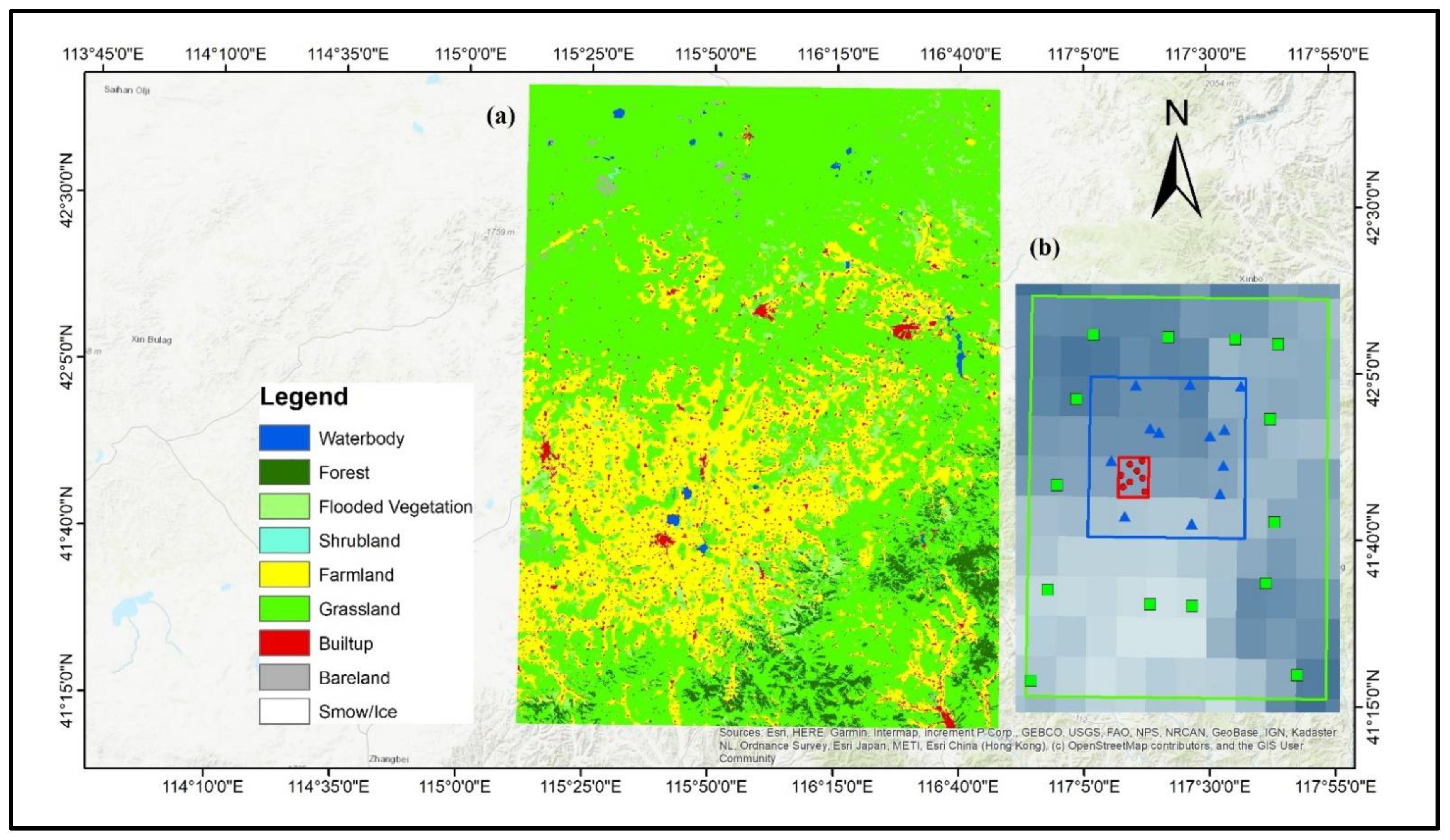


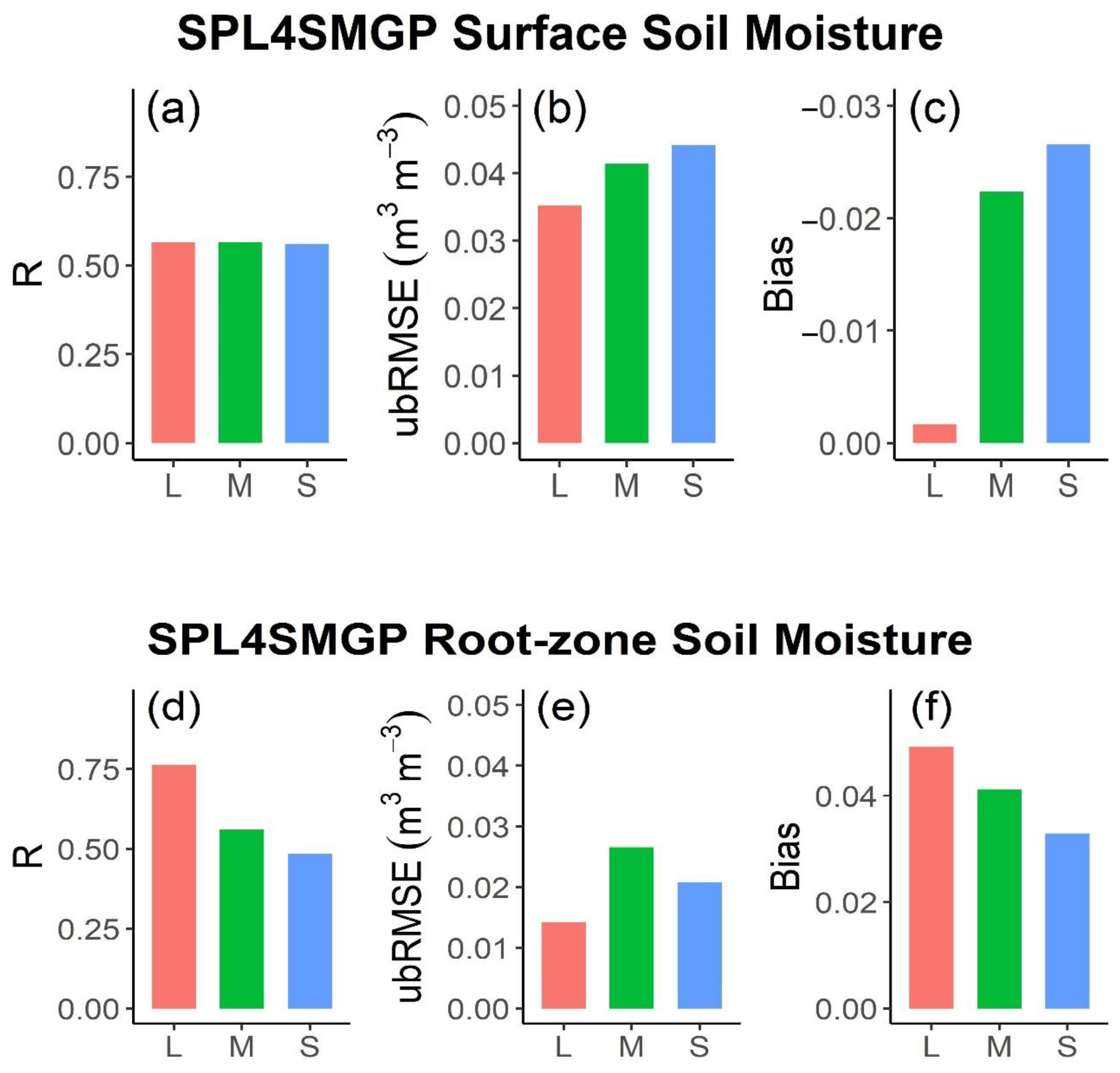
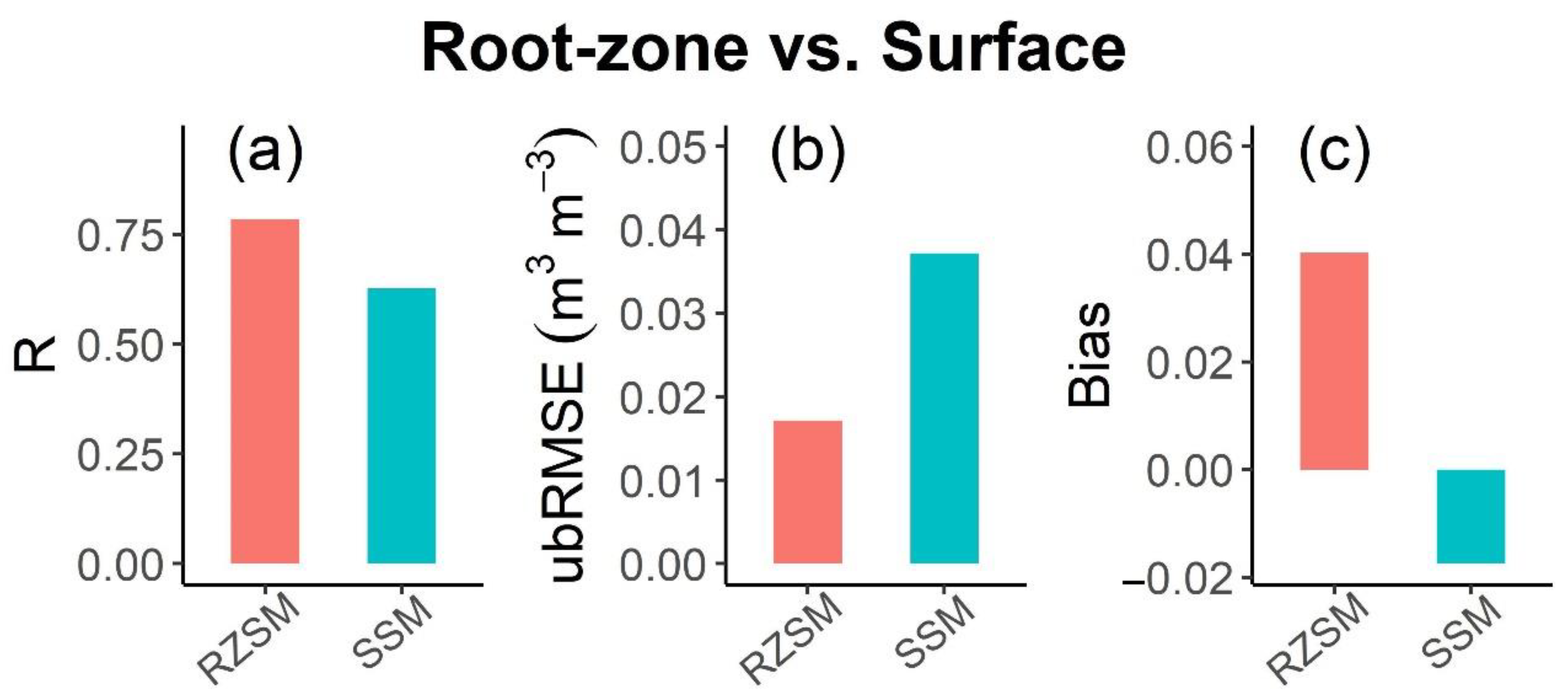


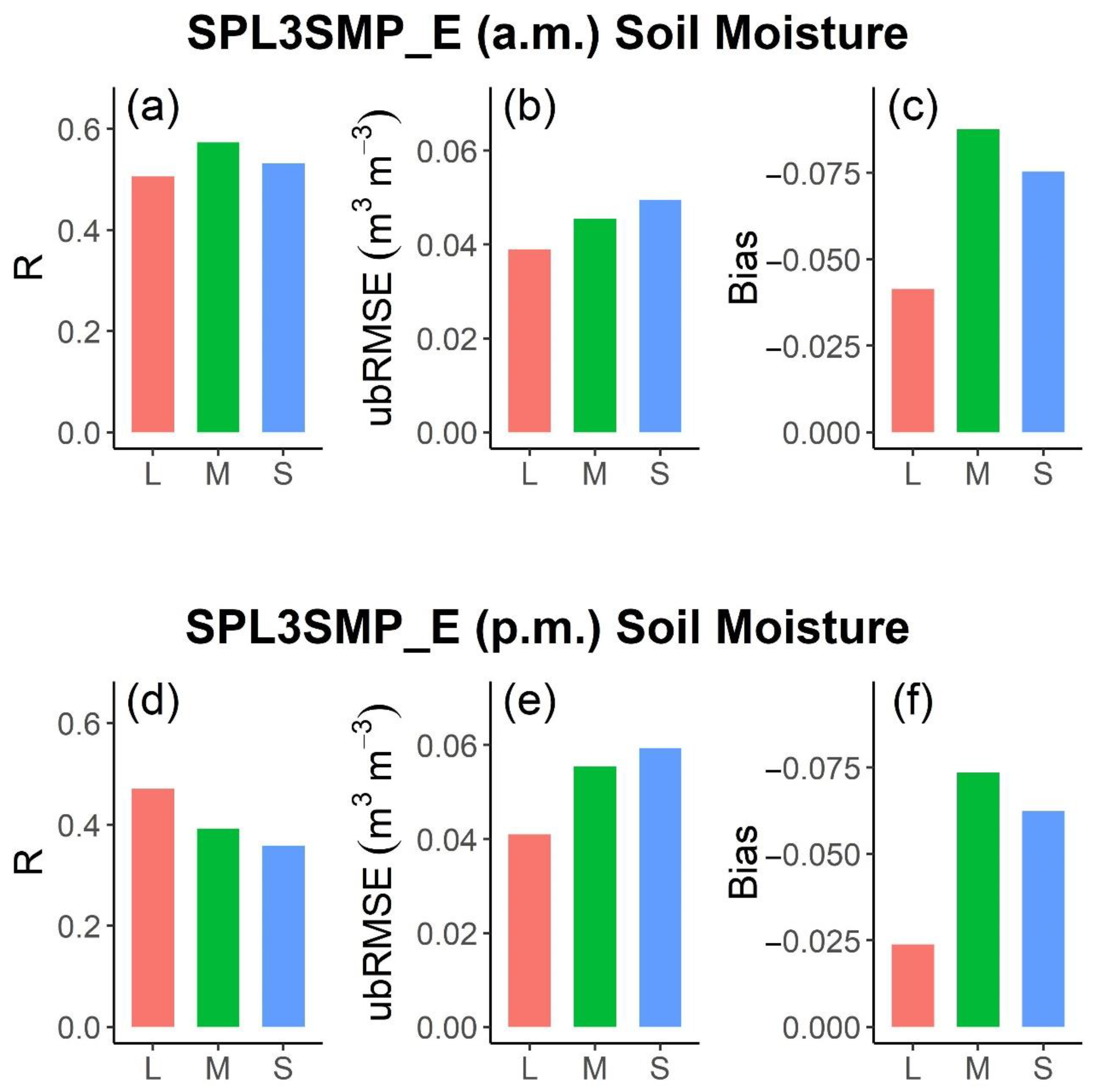
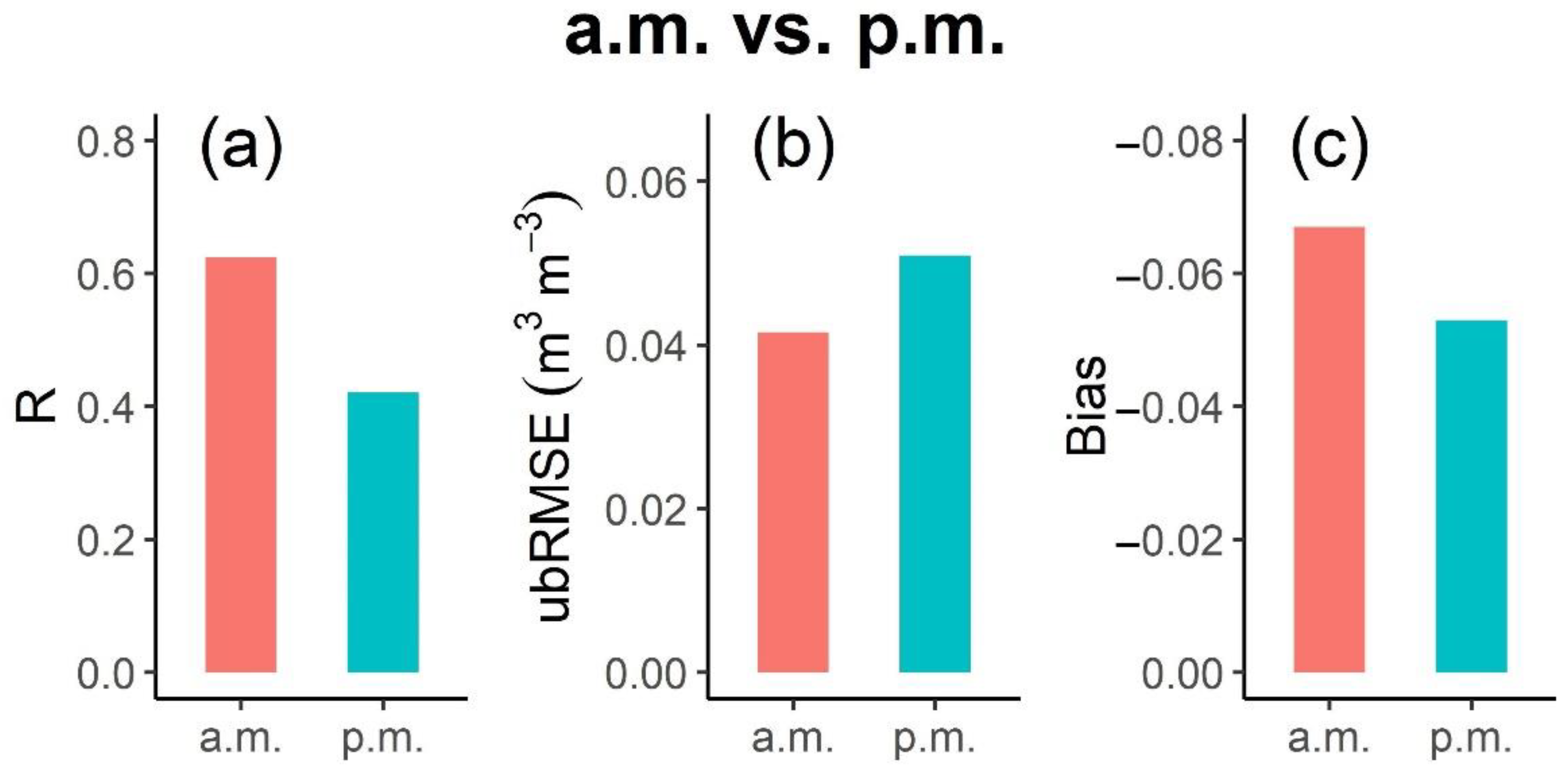
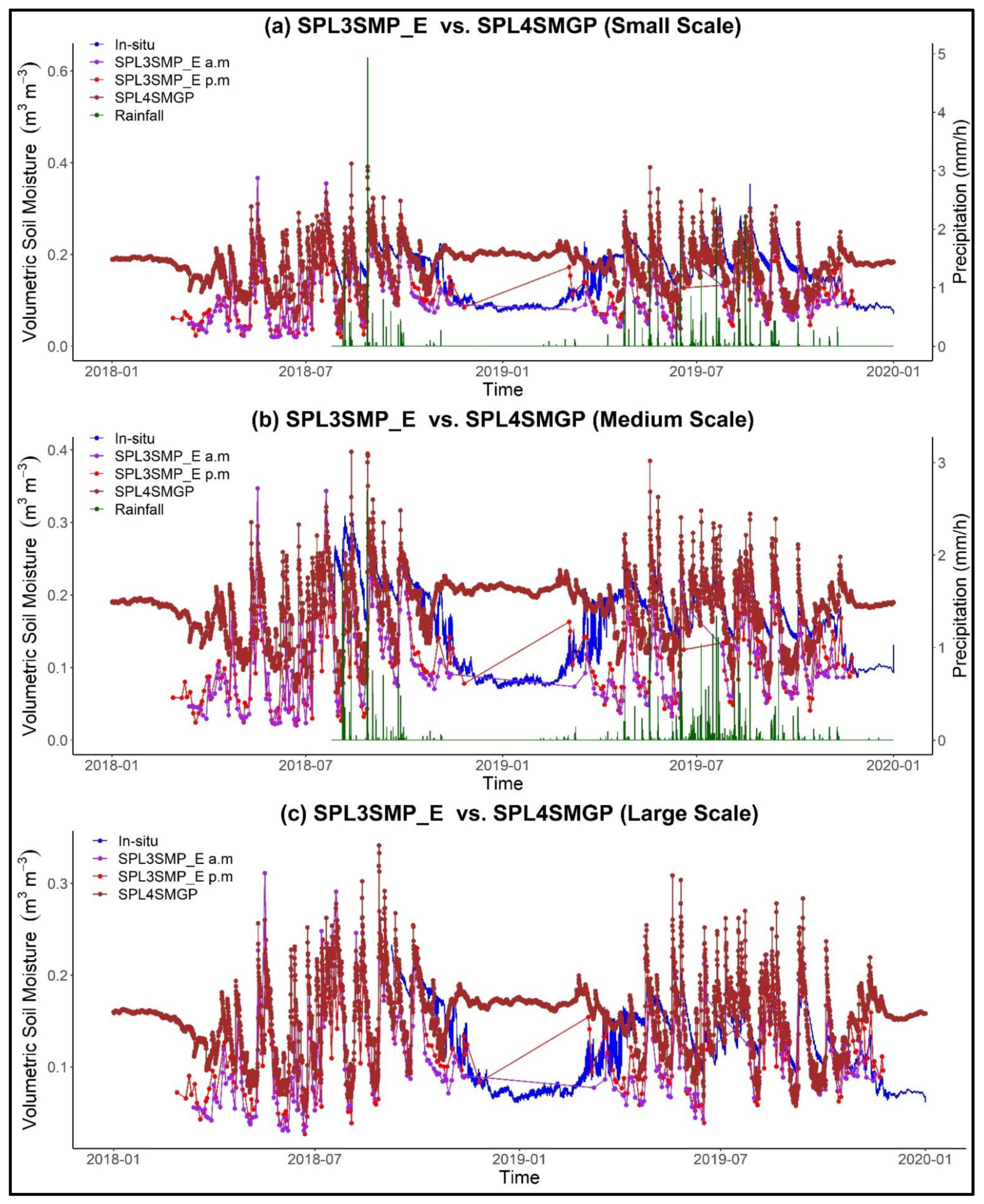



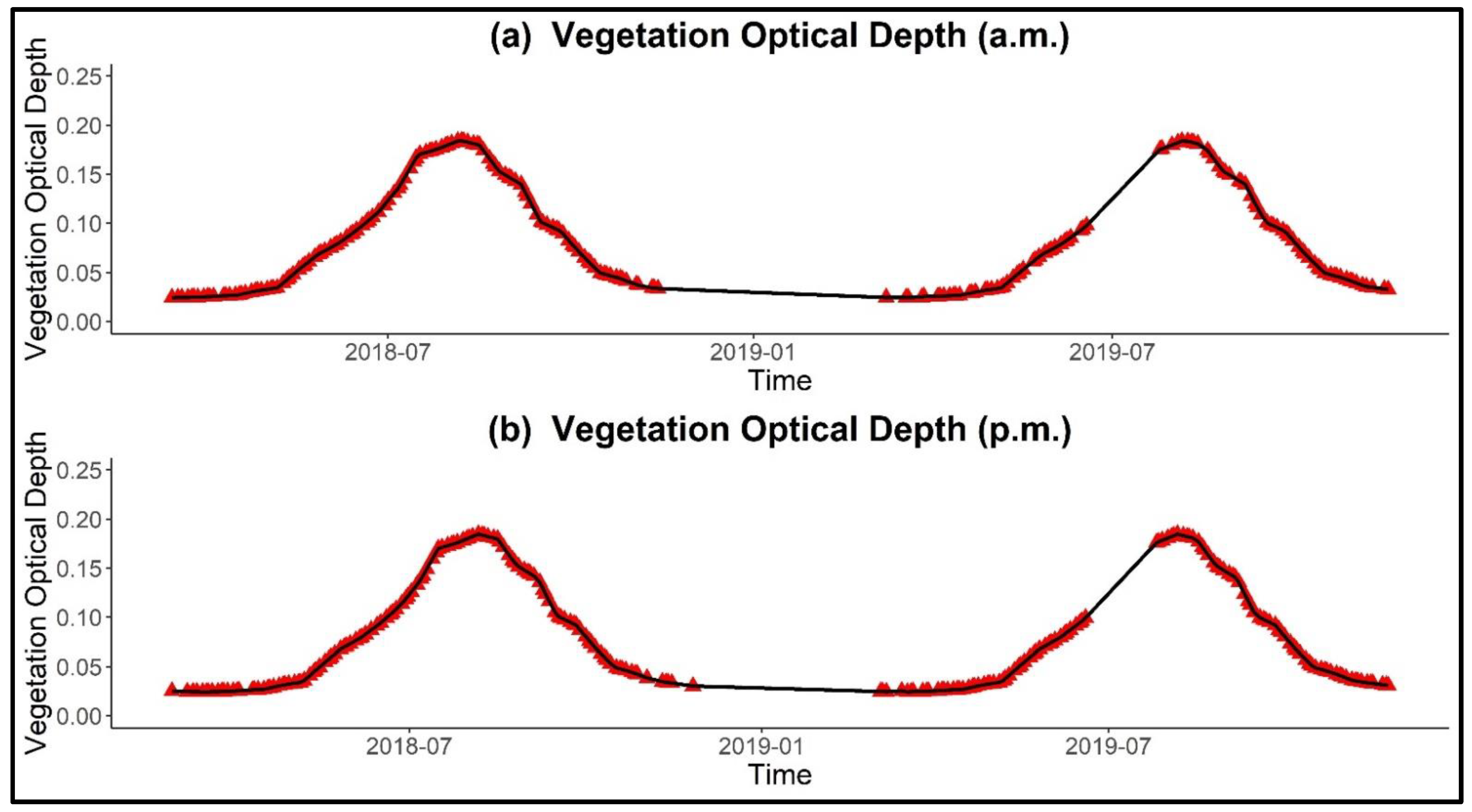
| Station ID | Longitude (Degree) | Latitude (Degree) | Setup Time (Local Time) | Elevation (m) | Vegetation Cover |
|---|---|---|---|---|---|
| S1 | 115.945717 | 42.006639 | 19 July 2018 12:53 | 1368 | Farmland |
| S2 | 115.937800 | 42.040172 | 19 July 2018 15:00 | 1363 | Grassland |
| S3 | 115.919400 | 42.057144 | 18 July 2018 18:40 | 1343 | Grassland |
| S4 | 115.935069 | 42.082669 | 4 September 2018 10:17 | 1357 | Grassland |
| S5 | 115.894050 | 42.073939 | 18 July 2018 15:30 | 1327 | Grassland |
| S6 | 115.865733 | 42.045544 | 28 September 2018 11:04 | 1331 | Grassland |
| S7 | 115.896111 | 42.029722 | 14 August 2018 09:08 | 1332 | Grassland |
| S8 | 115.873056 | 42.017500 | 4 August 2018 18:36 | 1334 | Grassland |
| M1 | 115.855928 | 41.965572 | 4 September 2018 11:56 | 1343 | Grassland |
| M2 | 115.809444 | 42.105278 | 14 August 2018 11:30 | 1451 | Grassland |
| M3 | 116.082500 | 41.949722 | 14 August 2018 15:41 | 1466 | Farmland |
| M4 | 116.185508 | 42.095956 | 21 July 2018 09:51 | 1394 | Grassland |
| M5 | 116.188236 | 42.185553 | 20 July 2018 14:30 | 1433 | Grassland |
| M6 | 115.938742 | 42.186800 | 4 September 2018 09:02 | 1308 | Grassland |
| M7 | 115.968181 | 42.176983 | 18 July 2018 12:30 | 1330 | Grassland |
| M8 | 115.888611 | 42.306389 | 13 August 2018 10:50 | 1363 | Grassland |
| M9 | 116.070372 | 42.305539 | 13 August 2018 14:13 | 1280 | Grassland |
| M10 | 116.242753 | 42.302567 | 13 August 2018 17:22 | 1327 | Woodland |
| M11 | 116.139483 | 42.168933 | 20 July 2018 16:35 | 1470 | Grassland |
| M12 | 116.176603 | 42.025097 | 21 July 2018 08:18 | 1354 | Grassland |
| L1 | 115.538853 | 41.550761 | 1 September 2018 11:12 | 1433 | Grassland |
| L2 | 115.603142 | 41.780069 | 1 September 2018 13:40 | 1401 | Grassland |
| L3 | 115.628383 | 42.042175 | 1 September 2018 17:30 | 1452 | Grassland |
| L4 | 115.689708 | 42.257611 | 2 September 2018 11:54 | 1338 | Grassland |
| L5 | 115.742808 | 42.419742 | 2 September 2018 09:49 | 1427 | Grassland |
| L6 | 116.333303 | 41.802947 | 5 September 2018 14:27 | 1369 | Grassland |
| L7 | 116.342378 | 42.214089 | 3 September 2018 13:51 | 1364 | Woodland |
| L8 | 116.361031 | 41.955311 | 3 September 2018 11:15 | 1435 | Grassland |
| L9 | 116.087342 | 41.744736 | 4 September 2018 15:42 | 1443 | Grassland |
| L10 | 115.945078 | 41.746911 | 4 September 2018 13:53 | 1410 | Grassland |
| L11 | 116.222711 | 42.411972 | 2 September 2018 14:19 | 1280 | Grassland |
| L12 | 116.367775 | 42.401206 | 2 September 2018 16:07 | 1315 | Grassland |
| L13 | 115.996558 | 42.416431 | 3 September 2018 17:24 | 1329 | Grassland |
| L14 | 116.437414 | 41.574433 | 5 September 2018 11:19 | 1383 | Grassland |
| The L3 a.m. Product | The L3 p.m. Product | |||||||||
|---|---|---|---|---|---|---|---|---|---|---|
| Vegetation Types | R | RMSE | Bias | ubRMSE | N | R | RMSE | Bias | ubRMSE | N |
| Grassland | 0.255 | 0.090 | -0.071 | 0.056 | 146 | 0.481 | 0.076 | −0.060 | 0.047 | 160 |
| Farmland | 0.432 | 0.068 | -0.043 | 0.052 | 146 | 0.331 | 0.067 | −0.035 | 0.057 | 160 |
| Woodland | 0.275 | 0.059 | -0.013 | 0.059 | 146 | 0.084 | 0.065 | −0.001 | 0.065 | 160 |
| The L4 SSM Product | The L4 RZSM Product | |||||||||
| Vegetation Types | R | RMSE | Bias | ubRMSE | N | R | RMSE | Bias | ubRMSE | N |
| Grassland | 0.447 | 0.051 | −0.024 | 0.045 | 2504 | 0.707 | 0.040 | 0.036 | 0.019 | 2504 |
| Farmland | 0.385 | 0.052 | 0.001 | 0.052 | 2496 | 0.269 | 0.052 | 0.041 | 0.031 | 2496 |
| Woodland | 0.203 | 0.065 | 0.043 | 0.042 | 2296 | 0.633 | 0.106 | 0.106 | 0.033 | 2296 |
Publisher’s Note: MDPI stays neutral with regard to jurisdictional claims in published maps and institutional affiliations. |
© 2022 by the authors. Licensee MDPI, Basel, Switzerland. This article is an open access article distributed under the terms and conditions of the Creative Commons Attribution (CC BY) license (https://creativecommons.org/licenses/by/4.0/).
Share and Cite
Nadeem, A.A.; Zha, Y.; Shi, L.; Ran, G.; Ali, S.; Jahangir, Z.; Afzal, M.M.; Awais, M. Multi-Scale Assessment of SMAP Level 3 and Level 4 Soil Moisture Products over the Soil Moisture Network within the ShanDian River (SMN-SDR) Basin, China. Remote Sens. 2022, 14, 982. https://doi.org/10.3390/rs14040982
Nadeem AA, Zha Y, Shi L, Ran G, Ali S, Jahangir Z, Afzal MM, Awais M. Multi-Scale Assessment of SMAP Level 3 and Level 4 Soil Moisture Products over the Soil Moisture Network within the ShanDian River (SMN-SDR) Basin, China. Remote Sensing. 2022; 14(4):982. https://doi.org/10.3390/rs14040982
Chicago/Turabian StyleNadeem, Adeel Ahmad, Yuanyuan Zha, Liangsheng Shi, Gulin Ran, Shoaib Ali, Zahid Jahangir, Muhammad Mannan Afzal, and Muhammad Awais. 2022. "Multi-Scale Assessment of SMAP Level 3 and Level 4 Soil Moisture Products over the Soil Moisture Network within the ShanDian River (SMN-SDR) Basin, China" Remote Sensing 14, no. 4: 982. https://doi.org/10.3390/rs14040982
APA StyleNadeem, A. A., Zha, Y., Shi, L., Ran, G., Ali, S., Jahangir, Z., Afzal, M. M., & Awais, M. (2022). Multi-Scale Assessment of SMAP Level 3 and Level 4 Soil Moisture Products over the Soil Moisture Network within the ShanDian River (SMN-SDR) Basin, China. Remote Sensing, 14(4), 982. https://doi.org/10.3390/rs14040982






